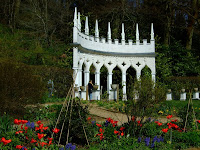 Last summer's floods focused the country's attention on the areas of Gloucestershire near the Severn River. Our weekend's accommodation was at Stonehouse, in the centre of this area and on Saturday we explored the area north of Stonehouse.
Last summer's floods focused the country's attention on the areas of Gloucestershire near the Severn River. Our weekend's accommodation was at Stonehouse, in the centre of this area and on Saturday we explored the area north of Stonehouse.Tewkesbury and Upton Upon Severn were often in the news during the floods. Upton Upon Severn is a very attractive town, built on the banks of the river.
 Tewkesbury is built at the confluence of the Severn and Avon Rivers, and became an island during the floods. There is nothing outwardly to be seen today, except a marker on the boating club showing the incredible level the water got to. This is a much larger town than Upton, and was a very important and wealthy town in past centuries. This is reflected in the large and impressive Abbey purchased back from Henry VIII, after the dissolution, by the townsfolk for £453.
Tewkesbury is built at the confluence of the Severn and Avon Rivers, and became an island during the floods. There is nothing outwardly to be seen today, except a marker on the boating club showing the incredible level the water got to. This is a much larger town than Upton, and was a very important and wealthy town in past centuries. This is reflected in the large and impressive Abbey purchased back from Henry VIII, after the dissolution, by the townsfolk for £453. Between these two towns, we did a side trip to see a very different place of worship, dating from 1120. St Mary's Church at Kempley, has some of the best original wall-paintings in the UK, the oldest complete roof in the country and two doors made in 1120. This little church is quite stunning.
Between these two towns, we did a side trip to see a very different place of worship, dating from 1120. St Mary's Church at Kempley, has some of the best original wall-paintings in the UK, the oldest complete roof in the country and two doors made in 1120. This little church is quite stunning.From here we travelled south to the very pleasant town of Painswick, known as 'The Queen of the Cotswolds'.


99 yew trees, all neatly clipped surround the church: apparently the devil stops the 100th tree from growing!
 Nearby the town are the Painswick Rococo Gardens. Following discovery of a painting of the gardens as they were in the 18th century, the garden has been restored in the original style and, because this style was only popular for a brief period, these are now the only remaining rococo gardens in Britain.
Nearby the town are the Painswick Rococo Gardens. Following discovery of a painting of the gardens as they were in the 18th century, the garden has been restored in the original style and, because this style was only popular for a brief period, these are now the only remaining rococo gardens in Britain.From here we had an enjoyable country tour on narrow back roads to the very pretty town of Bisley, which cascades down a hillside. An interesting local legend is that Princess Elizabeth died while staying here, and rather than face
 King Henry 8th's wrath, her nurse and the family she was staying with; after failing to find a suitable replacement girl, replaced her with Neville Blunt, a son of Henry's illegitimate son. Neville thus shared a family likeness to the King but not, as has often been remarked upon, to Anne Boleyn, Elizabeth's mother. From here we travelled down the valleys to Chalford, a town once full of mills, and finally to Stonehouse.
King Henry 8th's wrath, her nurse and the family she was staying with; after failing to find a suitable replacement girl, replaced her with Neville Blunt, a son of Henry's illegitimate son. Neville thus shared a family likeness to the King but not, as has often been remarked upon, to Anne Boleyn, Elizabeth's mother. From here we travelled down the valleys to Chalford, a town once full of mills, and finally to Stonehouse.




No comments:
Post a Comment